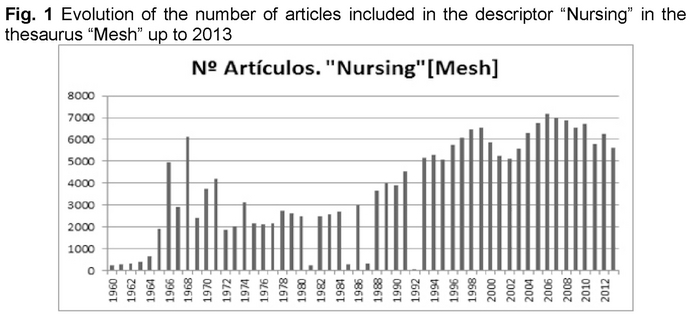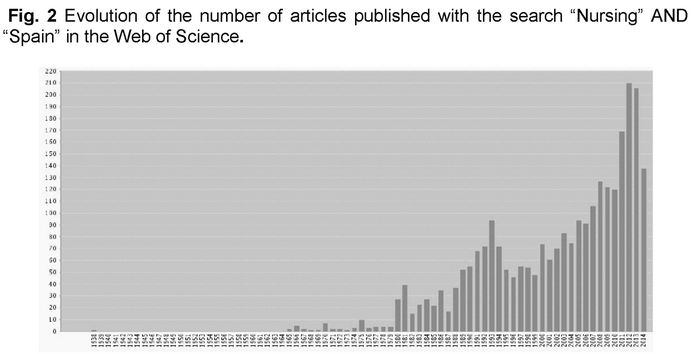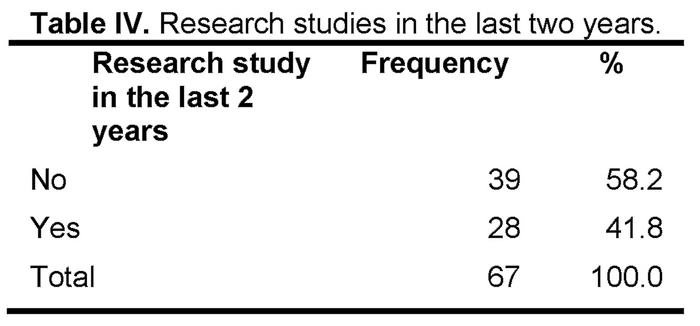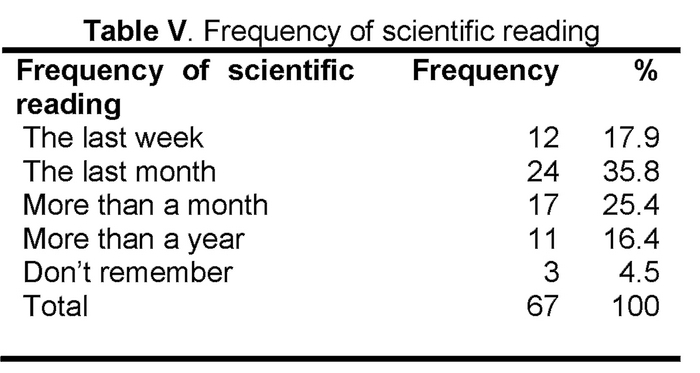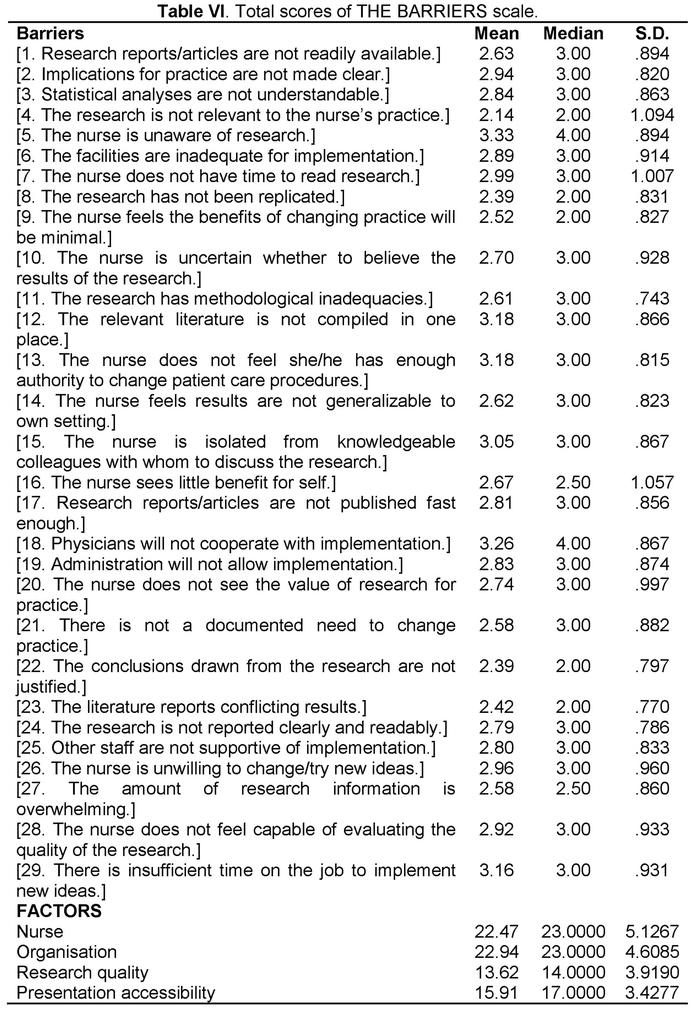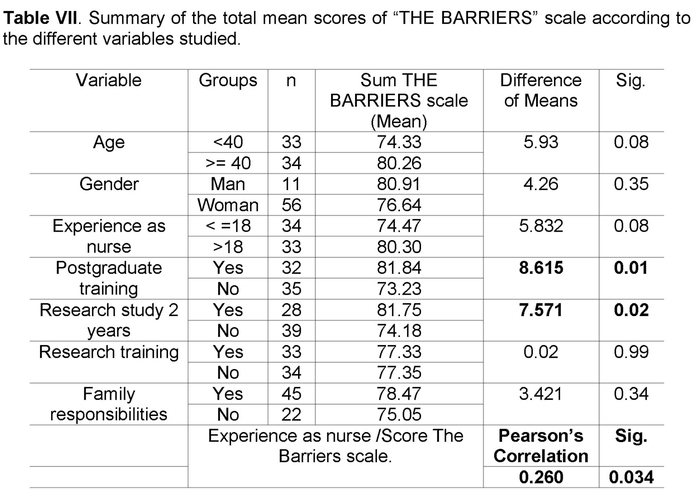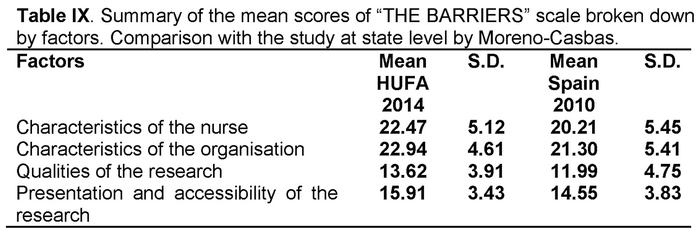My SciELO
Services on Demand
Journal
Article
Indicators
-
 Cited by SciELO
Cited by SciELO -
 Access statistics
Access statistics
Related links
-
 Cited by Google
Cited by Google -
 Similars in
SciELO
Similars in
SciELO -
 Similars in Google
Similars in Google
Share
Enfermería Global
On-line version ISSN 1695-6141
Enferm. glob. vol.15 n.43 Murcia Jul. 2016
ADMINISTRACIÓN-GESTIÓN-CALIDAD
Barriers to the utilisation of research. Descriptive study performed on nurses at a hospital in the southwest of Madrid
Barreras para la utilización de la investigación. Estudio descriptivo en profesionales de Enfermería en un hospital del sudoeste de Madrid
Guadarrama Ortega, David
Nurse. Research Unit. University Hospital Fundación Alcorcón. Madrid. Spain. E-mail: dguadarrama@fhalcorcon.es
ABSTRACT
Objectives: To identify barriers to the utilization of research as perceived by nurses at the University Hospital Alcorcón (HUFA) Foundation and their facilitators.
Specific objectives: To assess the differences in scale scores THE BARRIERS depending on the different variables studied.
Methods: A cross sectional study was conducted during May 2014. The study population were all nurses working in the HUFA. The questionnaire included THE BARRIERS scale of S.Funk et al. It was facilitated by an online survey distributed through the corporate mail hospital.
Results: 69 nurses (16%) completed the survey, 67 surveys were valid. The barriers identified with the highest score were: "The nurse is unaware of the research" mean = 3.33 (SD = 0.89); and " Physicians will not cooperate with implementation" mean = 3.26 (SD = 0.86). Statistically significant differences were found in the total score of THE BARRIERS scale based on experience as a nurse, post-graduate training, and have made previous research. No significant differences were found in terms of other variables.
Conclusions: Although lack of time is identified as the main barrier to research in most of the studies, here appears behind other as the unknowing of research or lack of cooperation. But lack of time appears as one of the main barriers in free text responses.
Key words: Nursing; Nurses; Barriers; Research Utilization.
RESUMEN
Objetivos. Identificar las situaciones, circunstancias o barreras que dificultan a la enfermería utilizar los resultados de las investigaciones en el Hospital Universitario Fundación Alcorcón (HUFA), así como sus facilitadores.
Objetivos específicos. Evaluar si existen diferencias en la puntuación de la escala THE BARRIERS en función de las distintas variables estudiadas.
Métodos. Estudio observacional, descriptivo y transversal durante mayo 2014. La población de estudio fueron todas las enfermeras que trabajan en el HUFA. El cuestionario que incluye la escala THE BARRIERS de S.Funk et al. se facilitó mediante una encuesta on-line distribuida a través del correo corporativo del hospital.
Resultados. Respondieron 69 enfermeras (16%), fueron válidas 67 encuestas. Las barreras identificadas con mayor puntuación fueron: "La enfermera desconoce las investigaciones" media=3.33 (DE=0.89); y "Los médicos no colaboran en la implementación" media=3.26 (DE=0.86). Se encuentran diferencias estadísticamente significativas en la suma de la escala THE BARRIERS en función de la experiencia como enfermera, la formación post-grado, y haber realizado investigaciones previas. No se encuentran diferencias significativas en función del resto de variables.
Conclusiones. Aunque la falta de tiempo se identifica como la principal barrera para la investigación en la mayoría de los estudios, aquí aparece por detrás de otras como el desconocimiento de las investigaciones, la falta de colaboración, o que la información no está recogida en un solo lugar. Sin embargo el tiempo aparece como una de las principales barreras en las respuestas de texto libre.
Palabras clave: Enfermería; Barreras; Utilización de la investigación.
Introduction
Background
Nursing has not traditionally been based on scientific evidence and its practice has been supported by tradition and experience. In turn, nurses have not been given training on research. Moreover, the culture of many nurses is not favourable to research(1). However, the step taken by the nursing profession in Spain in 1977 by acceding to university level(2) has led to a growth in the amount of research performed by nurses(3). Research undertaken in Spanish nursing began in the form of doctoral theses(3), and this scientific production with a nursing theme has undergone a progressive and exponential increase(3).
Research has been conducted since the nineteen-nineties into the reasons or barriers identified by nurses as an impediment to research and its subsequent utilisation in clinical practice(4-6). In 1991 Sandra G. Funk proposed the BARRIERS scale which measured those circumstances that, according to nurses, act as barriers to the utilisation of the available research(4).
S. Funk classified the different "barriers" into four groups or "Factors": Characteristics of the nurse, characteristics of the organisation, quality of the research, and presentation and accessibility of the research(4). Along the same lines, Hunt finds different factors that have led to nurses being isolated from research and evidence, since many do not understand them, others do not believe them, another group does not know how to make use of them, and some are even forbidden to apply findings originating in research(6). Hunt suggests that the barriers to the use of research encompass five domains: the quality of the research, access to the research, the process for utilisation of the research, the attitude and knowledge of the nurses, and the organisation in which the results of the research are to be applied(6).
In 2010 a study was published which described the barriers to the use of research in centres throughout Spain(7), and this will serve as a reference to compare with the results of our study. In that study, the three barriers identified with the highest score were: "There is insufficient time on the job to implement new ideas", followed by "The nurse is unaware of the research" and "Physicians will not cooperate with implementation"(7).
Current state of the matter
Nurses perform little research compared to other scientific disciplines. To give an example, in a quick search in PubMed using the descriptors "Nursing" and "Medicine" we obtain slightly over 219,000 results in Nursing (Fig.1) compared to more than 800,000 articles in Medicine. In fact, this database includes the descriptor "Nursing Research" whilst the equivalent in medicine does not appear, taking it for granted that medicine has research associated with it. We can also observe how the studies included in the descriptor "Nursing" have increased exponentially. (Fig. 1) Whilst it is true that Spanish nursing was incorporated into universities (scientific realm par excellence) relatively late, since it became a university qualification its scientific activity in the form of published articles has increased exponentially. (Fig. 2) But although its importance is stressed by the Nursing schools, it continues to be one of the professions in the healthcare field that produces the least amount of research (it should not be forgotten that nurses are the most numerous body within this field).
Moreover, it should not be forgotten that the nursing profession disseminates the majority of the results of its research at congresses and conferences rather than through publication in scientific journals.
Justification
Since the opening in 1998 of the University Hospital Fundación Alcorcón (HUFA), the nurses of the centre have performed a great deal of research, especially taking into account the number of nursing professionals at the hospital compared with other larger hospitals of the Community of Madrid.
However, many nurses express their difficulties in conducting research and subsequently utilising the results of such research. The need to study this phenomenon at our centre arises as a result of these reflections.
The aim of the study undertaken is to ascertain and respond to the needs and difficulties of the nursing staff of the HUFA with regard to the application of care based on scientific evidence.
Aims
The main aim of the study is to identify the principle barriers that hinder the use by nurses of research results at the University Hospital Fundación Alcorcón, as well as their facilitators, via the use of THE BARRIERS scale of S. Funk.
Specific aims:
- To evaluate whether there are differences in the score of THE BARRIERS scale according to age and gender, years of experience, postgraduate training, the unit where the nurses work, family responsibilities, research training and research experience.
Material and methods
Design
An observational, descriptive and cross-sectional study was performed during the year 2014 at the University Hospital Fundación Alcorcó, Madrid.
A bibliographic search was carried out which enabled the research to be contextualised. Different databases or documentary sources were used for this: CINAHL, PubMed, CUIDEN, among others. The key words for the bibliographic search were: BARRIERS, NURSING RESEARCH (DESCRIPTOR). NURSING RESEARCH, BARRIERS.
Study population
The study population comprised all the nurses who work at the HUFA, both caregivers and managers.
The criteria for inclusion were: Nurses of the HUFA with an active e-mail address at the time of distribution of the survey.
In view of the number of nurses included in the last hospital directory (440 including specialist interns) it was decided to include all the nurses in the sample size since it is easily manageable and the survey was distributed by e-mail.
Data collection
The questionnaire with THE BARRIERS scale was administered via an on-line survey distributed through the corporate e-mail of the hospital at various times to facilitate its completion. To guarantee confidentiality the electronic mailbox "HUFA Enfermeras" was used, to which the survey was sent by e-mail. The questionnaire was hosted on a web platform for the performance of surveys that allows the subsequent exploitation of the data, in this case Google Docs® was chosen, specifically its forms option.
Data analysis
A descriptive analysis was performed of all the variables, giving the results in the form of percentages (qualitative) and mean and standard deviation (quantitative). The variables included in the questionnaire were:
• Age: quantitative variable measured by current age
• Gender: dichotomous qualitative variable (1=man; 2=woman)
• Years of experience: quantitative variable measured in years
• Postgraduate training: nominal qualitative variable
• Unit: nominal qualitative variable
• Family responsibilities: nominal qualitative variable
• Previous research studies: dichotomous qualitative variable (1=Yes; 2=No)
• Frequency of Reading of scientific articles: nominal qualitative variable
• Training on research topics in the last three years: dichotomous qualitative variable (1=Yes; 2=No)
To facilitate the analysis of the data, owing to the small sample, some of these variables have been transformed into dichotomous qualitative (years of experience, age, family responsibilities, postgraduate training).
• THE BARRIERS Scale. THE BARRIERS scale, published by S. Funk et al. in 1991, comprises 29 items classified in 4 factors. Each item is scored from 1 to 4 (1. To no extent, 2. To a little extent, 3. To a moderate extent, 4. To a great extent), with a fifth option that has no value assigned and which corresponds to the option "No opinion". The items were derived from the literature, on the basis of research data, and from the CURN Project (CURN Project Research Utilization Questionnaire (Crane, Pelz, & Horsley, 1977).
The four factors in which the items are classified are: characteristics of the adopter (nurse), characteristics of the organisation, characteristics of the innovation (qualities of the research), and characteristics of the communication (accessibility of the research).
It should be taken into account that item number 27 is not classified in any of the factors. However, it has been kept in the scale owing to comments by professionals in view of its interest. The maximum sum of the items of each factor is 32 for the first two and 24 for the last two.
Two versions of the scale are available to researchers:
• The original THE BARRIERS scale, reported in Applied Nursing Research in 1991, which asks respondents to provide their general perceptions of the barriers to the use of research.
• And a second version that personalises the instructions so that the responses are provided in relationship with the individual's own work setting.
For our study the second version was used since the aim was to obtain the results only for our centre.
The data were analysed with the statistical analysis program SPSS and Excel. To compare hypotheses Pearson's correlation coefficient and Student's t-test were used according to the type of study variable. In addition, to determine the level of statistical significance a p<0.05 was established.
Results
69 of the 417 nurses employed by the University Hospital Fundación Alcorcón responded to the survey. 67 of the 69 surveys received were considered valid.
Analysis of the socio-demographic and profession-related variables
- The mean age of the sample is 38.75 (SD: 6.8) ranging from 22 to 55 years.
- 83.6% of the nurses were women, compared to 16.4 men.
- The mean number of years of experience as a nurse was 16.73 (SD: 6.3) Range 1 to 34 years.
- As for postgraduate training, the following results were obtained. (Table I)
- The distribution of the responses by units was as follows: (Table II)
- The distribution of family responsibilities was that shown below. (Table III).
- 41.8% of respondents had performed some kind of research study in the last 2 years. (Table IV):
- With regard to the frequency of reading of scientific articles, the distribution of the sample was as follows (Table V):
- 49.3% of those surveyed had received training relating to research.
The total scores of "THE BARRIERS" scale obtained from the study are shown below (Table VI):
The barriers identified with the highest scores were:
1. "The nurse is unaware of the research" mean=3.33 (SD=0.89);
2. "Physicians will not cooperate with implementation" mean=3.26 (SD=0.86);
3. "The relevant literature is not compiled in one place" mean=3.18 (SD=0.86); and
4. "The nurse does not feel she/he has enough authority to change patient care procedures" mean=3.18 (SD=0.81).
The sum of the maximum scores of the scale give a value of 116 points, the mean of the total sums of the nurses surveyed being 74.95. Median 74 and SD: 13.57. Range: 45-98.
Taking into account the other variables studied, it was determined whether or not differences existed in the score of the scale according to such variables, which are described below. (Table VII)
- Results of the free text questions.
Furthermore, THE BARRIERS scale of S. Funk provides three more items for free response:
1. Are there other things you think are barriers to research utilization? If so, please list and rate each on the scale: (1) To no extent, (2) To a little extent, (3) To a moderate extent, (4) To a great extent. (Table VIII):
We can observe how insufficient time is the most-repeated barrier, followed by insufficient training.
2. To the question "Which of the above items do you feel are the THREE greatest barriers to nurses' use of research?"
The barriers most often mentioned as such were "insufficient time" (no. 29), "the nurse does not have authority" (no. 13) and "physicians will not cooperate with implementation" (no. 18).
3. What are the things you think facilitate research utilization?
Of the facilitators indicated by the respondents the aspects repeated most often are those relative to the recognised time within the working day (n=8) and training in research (n=8), followed by those relative to staff motivation in research by nursing managers (n=7).
Discussion
Although insufficient time is identified as the main barrier to the use of research(7), in this study it appears behind others such as being unaware of the research, insufficient cooperation, or that the information is not compiled in one place. This is possibly due to the fact that many of the nurses who have completed the questionnaire belong to units with more possibility to respond to the survey. However, time appears as one of the main barriers in free text responses.
By age groups, we observe a higher score on THE BARRIERS scale in those aged over 40, although this difference is not statistically significant (p=0.08). We can suspect that this is due to having used a small sample for the study, since there are differences in the barriers perceived according to experience as a nurse (p=0.03), since work experience is a factor associated with age.
We find significant differences according to whether the nurses have postgraduate training, but this is the group of professionals with the highest mean score in THE BARRIERS scale. This phenomenon also occurs in the group of nurses who have performed some kind of research study in the last 2 years.
In comparison with the results obtained at state level in the study by Moreno-Casbas et al(7), differences are found with regard to the mean scores for each factor (Table IX).
As we can see, the nurses of the HUFA find greater barriers for the utilisation of research.
The highest scoring barriers in the study at national level are "There is insufficient time on the job to implement new ideas" with a mean of 3.13 and SD of 1.08 and "The nurse is unaware of the research" with a mean of 2.84 and SD of 1.14. When we compare this to our study, we find that insufficient time appears as the fifth barrier with regard to score, however, the mean obtained by this item in this study is higher than that obtained in the study by Moreno-Casbas et al. (3.16 compared to 3.13). (Tables X and XI).
Study limitations
In the first place, we are faced with a low percentage of response to the questionnaire probably influenced by the ability of each nurse to handle computer tools. However, the possibility of sending the questionnaire by e-mail allowed the data to be obtained quickly and enabled it to reach a higher number of nurses.
The low percentage of responses is probably due to the fact that the nurses received the survey via corporate e-mail. And in most cases they had to respond during working hours. Paradoxically, the insufficient time mentioned by the nurses as the main barrier to the utilisation of research is what may have prevented them, in many cases, from responding to the survey for the evaluation of such barriers.
This low response rate explains that the distribution of the professionals surveyed by units is different from the real distribution of the nurses, obtaining a high percentage of responses from the Paediatric-Neonatology Unit and the Critical Care Unit.
Conclusions
This study provides us with a view of the limitations faced by the nurses of the HUFA for the performance and utilisation of research. Insufficient time or cooperation continue to be obstacles that nurses must repeatedly overcome.
The results having been obtained, the aim is to guide the actions of the research unit and the training needs of the personnel on research matters.
Received: 19 December 2014;
Accepted: February 2, 2016
References
1. García-Fernández FP. (Nursing research: an invisible reality?). Enfermería clínica (Internet). 2012 Jan (cited 2015 Dec 28);22(6):283-5. Available from: http://www.sciencedirect.com/science/article/pii/S1130862112001477. [ Links ]
2. BOE.es - Documento BOE-A-1977-20006 (Internet). (cited 2016 Feb 8). Available from: https://www.boe.es/diarioboe/txt.php?id=BOE-A-1977-20006. [ Links ]
3. García-García I, Gozalbes Cravioto E. Investigación en Enfermería y en Historia de la Enfermería en España.Index de Enfermería. 2012;21(1-2):100-4. http://scielo.isciii.es/scielo.php?script=sciarttext&pid=S1132-12962012000100023&lng=es&nrm=iso&tlng=es. [ Links ]
4. Funk SG, Champagne MT, Wiese RA, Tornquist EM. BARRIERS: the barriers to research utilization scale. Appl Nurs Res. United States; 1991;4(1):39-45. http://barriers.web.unc.edu/. [ Links ]
5. Funk SG, Tornquist EM, Champagne MT. Barriers and facilitators of research utilization. An integrative review. Nurs Clin North Am. School of Nursing, University of North Carolina at Chapel Hill, USA.; 1995;30(3):395-407. [ Links ]
6. Hunt JM. Barriers to research utilization. J Adv Nurs. England; 1996;23(3):423-5. [ Links ]
7. Moreno-Casbas T, Fuentelsaz-Gallego C, Gonzalez-Maria E, Gil de Miguel A. Barreras para la utilización de la investigación. Estudio descriptivo en profesionales de enfermería de la práctica clínica y en investigadores activos. Enferm Clin 2010 May-Jun;20(3):153-164. http://www.sciencedirect.com/science/article/pii/S113086211000015X. [ Links ]











 text in
text in 

